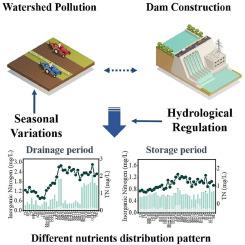当前位置:
X-MOL 学术
›
Water Res.
›
论文详情
Our official English website, www.x-mol.net, welcomes your feedback! (Note: you will need to create a separate account there.)
Dams alter the control pattern of watershed land use to riverine nutrient distribution: Comparison of three major rivers under different hydropower development levels in Southwestern China
Water Research ( IF 11.4 ) Pub Date : 2024-06-16 , DOI: 10.1016/j.watres.2024.121951 Xiaolei Xing , Peifang Wang , Xun Wang , Qiusheng Yuan , Bin Hu , Sheng Liu
Water Research ( IF 11.4 ) Pub Date : 2024-06-16 , DOI: 10.1016/j.watres.2024.121951 Xiaolei Xing , Peifang Wang , Xun Wang , Qiusheng Yuan , Bin Hu , Sheng Liu

|
Land use plays a critical role in managing water quality in a watershed, as it governs the import and distribution of nutrients. In addition to the land use, some rivers in Southwest China are encountering a new environmental stressor of damming, which is being driven by the national strategy of hydropower development. However, the coupling effect of land use and dams on nutrients remains poorly understood, challenging the effective management of riverine water quality. Therefore, this study examined the nutrients in the Nu, Yarlung Tsangpo (YT), and Lancang (LC) Rivers, which have no dam, 1 dam, and 11 dams, respectively, during different regulatory periods (spring and fall) to identify variations in nutrient control patterns influenced by land use and dams. The findings suggested that an increase in hydropower development contributed to a notable shift in nutrient patterns from land use regulation towards dam regulation and coupling effects. Land use dominated the nutrient variations of the Nu (27.4 %–32.8 %) and low hydropower development YT (25.2 %–30.9 %) Rivers during both seasons, but the primary contributors to the nutrient variations of the high hydropower development LC River were dams (17.9 %–41.6 %) and coupling effects (16.5 %–29.0 %). Dams transform nutrient levels and compositions through internal reservoir cycling, decoupling land use and nutrients. Partial least-squares structural equation model analysis further suggested that the coupling effects of the LC River were seasonal-specific, which was primarily attributed to hydrological variations that affected their interactions. During spring, the reservoir underwent a drainage mode characterized by high-level nutrients in the bottom water. Combined with the import of riverine nutrients, it exacerbated the increase of nutrients (synergistic effect). In contrast, the reservoir transitioned into a storage mode where it intercepted nutrients from the upstream and watershed during the fall, leading to a reduction in the previously observed increasing trend and an increase in nutrient variability (antagonism effect).
中文翻译:

大坝改变流域土地利用对河流养分分布的控制模式——西南地区不同水电开发水平下三大河流的比较
土地利用在流域水质管理中发挥着至关重要的作用,因为它控制着养分的进口和分配。除了土地利用之外,在国家水电开发战略的推动下,西南地区的一些河流还面临着新的筑坝环境压力。然而,土地利用和水坝对营养物的耦合效应仍然知之甚少,这给河流水质的有效管理带来了挑战。因此,本研究分别考察了怒江、雅鲁藏布江(YT)和澜沧江(LC)在不同监管时期(春季和秋季)的养分变化,这些河流分别是无坝、1坝和11坝。受土地利用和水坝影响的养分控制模式。研究结果表明,水电开发的增加导致养分模式从土地利用调节向大坝调节和耦合效应的显着转变。土地利用主导了怒江 (27.4%–32.8%) 和低水电开发 YT 河 (25.2%–30.9%) 两个季节的养分变化,但高水电开发 LC 河养分变化的主要贡献者是水坝(17.9%–41.6%)和耦合效应(16.5%–29.0%)。水坝通过内部水库循环改变养分水平和成分,使土地利用和养分脱钩。偏最小二乘结构方程模型分析进一步表明,LC河的耦合效应具有季节性特征,这主要归因于影响其相互作用的水文变化。春季,水库处于底水富营养化的排水模式。 与河流养分的输入相结合,加剧了养分的增加(协同效应)。相反,水库在秋季转变为蓄水模式,拦截上游和流域的养分,导致之前观察到的增加趋势减少,养分变异性增加(拮抗效应)。
更新日期:2024-06-16
中文翻译:

大坝改变流域土地利用对河流养分分布的控制模式——西南地区不同水电开发水平下三大河流的比较
土地利用在流域水质管理中发挥着至关重要的作用,因为它控制着养分的进口和分配。除了土地利用之外,在国家水电开发战略的推动下,西南地区的一些河流还面临着新的筑坝环境压力。然而,土地利用和水坝对营养物的耦合效应仍然知之甚少,这给河流水质的有效管理带来了挑战。因此,本研究分别考察了怒江、雅鲁藏布江(YT)和澜沧江(LC)在不同监管时期(春季和秋季)的养分变化,这些河流分别是无坝、1坝和11坝。受土地利用和水坝影响的养分控制模式。研究结果表明,水电开发的增加导致养分模式从土地利用调节向大坝调节和耦合效应的显着转变。土地利用主导了怒江 (27.4%–32.8%) 和低水电开发 YT 河 (25.2%–30.9%) 两个季节的养分变化,但高水电开发 LC 河养分变化的主要贡献者是水坝(17.9%–41.6%)和耦合效应(16.5%–29.0%)。水坝通过内部水库循环改变养分水平和成分,使土地利用和养分脱钩。偏最小二乘结构方程模型分析进一步表明,LC河的耦合效应具有季节性特征,这主要归因于影响其相互作用的水文变化。春季,水库处于底水富营养化的排水模式。 与河流养分的输入相结合,加剧了养分的增加(协同效应)。相反,水库在秋季转变为蓄水模式,拦截上游和流域的养分,导致之前观察到的增加趋势减少,养分变异性增加(拮抗效应)。











































 京公网安备 11010802027423号
京公网安备 11010802027423号